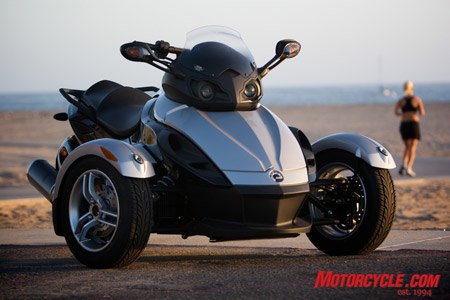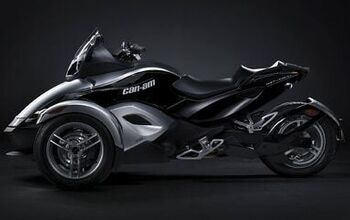2008 Can-Am Spyder Review - Motorcycle.com
Motorcycles, and more so scooters, are all the rage this summer. The heat of the summer and the heat of the current U.S. economy have helped to create an air of need and interest in alternative means of transportation.
For some, it’s the want to save a few dollars. For others, the visual appeal grabs their attention more than the savings. Some bikes, like the Piaggio MP3, fill both those wants by being both efficient and unique. Less efficient yet more attention-getting is the Can-Am Spyder.
You might recall Captain Duke’s ride report about a year ago wherein we read about all the tire-shredding fun on a short-term ride around California’s Orange County. In his story we learned about the Stability Control System, the Traction Control System and the entertaining gasps from the public.
This summer, while Kevin was busy testing bikes you haven’t yet read about, I climbed aboard the saddle-spacious Spyder ship for a longer-term test in order to gain some living-with insight. Riding the exact same model and color that Kevin rode last fall, my experience on the Spyder was similar to his. In short, it’s called a roadster for a reason. The ride is more akin to sitting atop a Mazda Miata than riding a big super-cruiser motorcycle. The Spyder offers most of the performance of a traditional motorcycle with some of the peace-of-mind you can get in the relative security of a cage, a convertible sports car in this case.
Toss in the knowledge gleaned from a few hundred more miles in the saddle than Kevin had, and I can tell you it’s a workout if you try to hustle this three-wheeler around the canyons like we do with our two-wheeled machines. Having a second tire up front – many times larger than that of your standard Pilot Sport – not only gives the added security of more contact patch, it also means more road-gripping friction that results in heavier steering.
The 106-horsepower (at the crankshaft) Rotax V-Twin-powered Spyder, however, is fully capable of tearing up the asphalt in a straight – the Spyder is a rolling burnout machine! In the canyons, it’s a whole different ball game. Not having a bucket seat like that in your average automobile to help manage your body weight, all the shifting tonnage is thrust upon your wrists. After a while, that’s no fun. Without the kinetic experience of leaning into a turn as on a bike, you’ll need Popeye-like forearms to hustle through the canyons with any great pace, despite the trike’s responsive power-assisted steering.
The Spyder is meant for cruising, and it does that with style and eye-catching grace. But keep “both hands on the wheel,” as the steering is so responsive that when you cruise with one hand resting on your lap, minute inputs to the throttle hand is quickly delivered to the leading pair of wheels, leading to a jittery straight-line ride until you tighten up your body and grip to get used it. By then you’ve defeated the relaxation found by removing your left hand from the equation.
Swinging your leg over the Spyder, you’ll find perhaps the largest saddle in the biz. Very reminiscent of a personal watercraft saddle; probably because Can-Am’s parent company also produces ATVs and PWCs – it’s what they know. And what they deliver is a saddle built for two, with enough room to carry four riders. Long-travel comfort is also built in. With its carrying capacity, the Spyder would make an excellent get-out-of-town-and-ride-to-Canada kind of touring machine. Strap on the available 22.3-liter passenger seat bag ($129.99) – which is also designed to fit into the front storage bin – and/or the 4.7-liter tank bag ($99.99) to haul your camera cards, sunscreen, underoos and sea shell collection in Can-Am-branded style.
When you take that significant other out for a ride, you may opt for the available Makrolon polycarbonate custom windscreen ($159.99) to help keep the fly-away hairs from getting completely out of control. You don’t wanna see your best girl looking like a mangy mutt, do you? The screen is 14 inches tall and comes only in clear - sorry, folks, you’ll have to keep wearing the rose-colored sunglasses to keep living the dream.
While your pampering both you and the wifey/husband, consider the passenger backrest, offering 2 inches of forward and rear adjustment ($249.99). However, the backrest needs to be mounted to the optional rear sport rack. The painted cast-aluminum rack ($399.99) comes in silver and perfectly complements the overall design of your Spyder – even with the extra baggage (your passenger) and luggage.
If you’re a rider escaping from life at home and ride to be alone, you’ll want to cap off the tail end of the saddle with the optional color-matched seat cowl ($199.99). You might also like the smoked-out and V-notched Ultrasport windshield ($129.99) to beefen up your Spyder’s manliness. Visit the BRP website to see all the trick accessories available – from pipes to caliper trim.
In the city, there’s no way you can lane share with the Spyder like we do with two-wheeled rides here in California, but you can relish in the fact that you can carry more groceries within the 44-liter storage bin up front than humanly possible. Large enough to portage for personal survival needs (like a 4-bottle white-wine club delivery from Laetitia Winery), the luggage compartment can hold two full-size helmets.
But navigating through a city’s traffic congestion reveals a few drawbacks. Not only is the Spyder much less maneuverable than a single-track vehicle, it also has a difficult time shedding heat from the engine.
During a particularly heavy traffic glut on the 210 freeway in 111-degree ambient temperature, the crawling Spyder could take no more and communicated an ominous message on its gauges: “Limp-home Mode.” With minimal air flowing over its right-side-mounted radiator (the left side is reserved for the oil cooler) while stuck in traffic, the Spyder electronically switched over to an injection and timing program which limited revs and power. After 10 minutes cooling off my own body off in the nearest Starbucks (with the Spyder parked in the shade of the Starbucks next door), the engine’s computer reset itself into normal programming and I was able to get back underway.
On the bright side, this three-wheeler is a top-shelf looker, keeping the heads of passers-by swiveling mile after mile. The most unique rubber-necking experience I had was the impromptu signage from a fellow freeway traveler. Scrawled upon some cardboard scraps the driver found in his pick-up’s cabin were just two words “Custom” and beneath that “Factory,” followed by a question mark and held up to the window. I smiled and thumbed up, indicating the number 2 in reply. The surprise in his eyes said the same as every other person I spoke to at the curb: “Wow!” The Spyder is surely something to be proud of everywhere you go.
When the dust settled and the 7.1-gallon tank was replenished, the miles per gallon we recorded hovered in the mid 20s. I wouldn’t call that efficient, but I suppose the fun factor makes up for the carbon footprint.
At the end of the day, be sure that you’ve got a second garage door or parking space to house the Spyder. It’s 60 inches wide and 104 inches long. That’s longer that the 4-wheeled 1956 Isetta with an overall length of just 90 inches! So you’re not going to be able to squeeze her into the garage next to the Microbus. Better news is that when you try, there’s a reverse gear to help you unstuck the Spyder from the spot you got yourself in by trying.
More good news for those that are keen on the Spyder: Can-Am announced a new model for 2009, called the SE5, that will sport a semi-automatic 5-speed transmission with thumb shifting and automatic downshifting.
"The SE5 allows even more enthusiasts to experience the thrill of the open road," said Chris Dawson, vice-president of Strategic Planning and Head of the Spyder program. "It provides a perfect opportunity for riders looking for the latest in clutchless shifting technology and a thrilling, sporty, get-on-and-go ride."
The added technology on the SE5 Spyder just might make sense for people interested in the Spyder, as they’re probably looking at this type of vehicle over a traditional motorcycle for specific reasons. The addition of push-button shifting and auto downshifts means even more time to enjoy the world you’ll be three-wheeling through.
The MSRP has gone up slightly since last reported by Motorcycle.com, the price for the SM5 (Sequential Manual 5-speed) now retails for $15,499, which is up from $14,995. The SE5 retails for $16,999. Both models come with a two-year limited warrantee. And the Millennium (yellow) color option is an additional $400.
Licensing and registration differs per state, so check with both the BRP site and your local DMV for more information. For example, in California, Delaware and South Carolina, consumers are only required to have a valid automobile license – no motorcycle endorsement, despite being generally classified as a motorcycle across the nation.
Related Reading
2009 Can-Am Spyder SE5 Review
2008 Can-Am Spyder Test
2008 Victory/Lehman Pitboss Trike Review
John Cusack rides Can-Am Spyder across Ireland
More by Alfonse Palaima

































Comments
Join the conversation